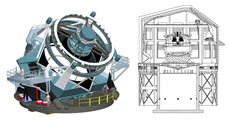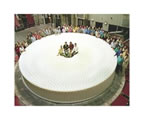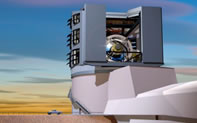Surveying the Universe
The Large Synoptic Survey Telescope
Steven M. Kahn
Kirk Professor of Physics
Director, LSST Project
Stanford University
About the Lecture

The goal of the Large Synoptic Survey Telescope (LSST) project is to conduct a 10-year survey of the sky that will deliver a 200 petabyte set of images and data products that will address some of the most pressing questions about the structure and evolution of the universe and the objects in it. The LSST survey is designed specifically to advance science in four particular areas: Dark Matter and Dark Energy; Hazardous Asteroids and the Remote Solar System; the Transient Optical Sky, and the Formation and Structure of the Milky Way While the LSST is designed to address profound scientific questions, the technical concept behind the project is remarkably simple: conduct a deep survey over an enormous area of sky, do it with a frequency that enables images of every part of the visible sky to be obtained every few nights, and continue in this mode for ten years creating vast astronomical catalogs, thousands of times larger than any previously compiled. As planned, the LSST will detect over three billion galaxies, providing detailed measurements of their red shifts, shapes, and properties. Through a technique called weak gravitational lensing, these data will be used to map the structure of dark matter in the universe and to show how the structure of dark matter has evolved with cosmic time. The results will provide very sensitive constraints on the nature of dark matter and dark energy. The LSST will also provide crucial data on the structure of the outer regions of the Milky Way, make a census of moving objects in the solar system, and discover transient phenomena in the universe on a wide range of timescales. The 8.4-meter LSST will use a special three-mirror design that provides an exceptionally wide field of view and has the ability to survey the entire sky in only three nights. Its solid state detectors will contain more than three billion pixels to take advantage of this extremely wide field of view and the high-quality images produced by the optical design. The camera is designed to extremely high quality data over long period so time with minimal maintenance requirements and downtime. The extremely wide field of view, large pixel count, high dynamic range and exquisite sensitivity of the optical train and detector electronics will produce more than 30 terabytes of high quality data every night. Over time it will produce the largest non-proprietary data set in the world. Storing and analyzing the data poses challenging hardware and software problems that constitute one of the most challenging aspects of the project. This lecture will discuss the scientific roots of the LSST project, its support, optical and detector design, supporting computational hardware and software, current progress on the lens, telescope and facilities, the initial observations that are planned, and the results that are expected, including some hoped for surprises.


About the Speaker

Steven M. Kahn is the Director of the Large Synoptic Survey Telescope (LSST). He oversees all aspects of project construction, and interactions with the funding organizations and the external scientific community. Steve previously served as Associate Laboratory Director of the SLAC National Accelerator Laboratory, Chair of the Physics Departments at Stanford and at Columbia Universities, and as Director, Deputy Director and Associate Director of the Kavli Institute for Particle Astrophysics and Cosmology at Stanford University, the Columbia Astrophysics Laboratory, and the Space Sciences Laboratory at Berkeley. He also was the US Principal Investigator for development of the Reflection Grating Spectrometer currently flying on the European Space Agency’s XMM-Newton Observatory. He has made significant contributions to X-ray astronomy, specifically with respect to high resolution X-ray spectroscopy of cosmic sources. His current research interests focus on cosmological investigations using large optical surveys and the development of space and ground-based instrumentation. He earned a BS at Columbia College, a PhD in Physics from UC Berkeley, and he was a Post-Doctoral Research Fellow at the Harvard-Smithsonian Center for Astrophysics.
Minutes
President Larry Millstein called the 2361st meeting of the Society to order at 8:07 p.m. He announced the order of business and welcomed new members. The minutes of the previous meeting were read and approved. President Millstein then introduced the speaker for the evening, Steven Kahn, the Kirk Professor of Physics and the Director of the LSST Project at Stanford University. His lecture was titled “Surveying the Universe: The Large Synoptic Survey Telescope”.
Dr. Kahn began by explaining that the LSST is a simple concept with profound implications for scientific discovery. By building a telescope that can take large pictures of the sky quickly, the entire sky visible from the southern hemisphere can be surveyed in just a few nights. When one survey is finished, the next survey begins, covering the same area of the sky. Repeating this process for ten years will provide a time-lapse record of approximately 1,000 highly detailed images of every part of the visible sky. This data will reveal everything that moves in the sky—such as asteroids, comets, stellar parallax—and everything that varies in brightness—such as variable stars, supernovae, quasars, and gamma ray bursts. Combining all of these images will make it possible to catalog all observable objects very accurately. The LSST project expects to detect twenty billion galaxies, four billion of which will be imaged with very high precision, allowing for deep data analysis.
Dr. Kahn noted that the number of galaxies that we can see is finite, not because the universe is finite, but because the observable universe is finite. The further outward we look, he explained, the further backward in time we are looking, even as far back as a time before galaxies existed. Astronomers estimate there are a theoretical maximum of 100 billion galaxies in the observable universe, so the 20 billion galaxies expected to be imaged by the LSST will be the first time we are seeing an appreciable percentage of everything that is possible to see.
Dr. Kahn explained that the “etendue”, or collecting power, of a telescope is the size of the primary mirror multiplied by the field of view of the camera. The primary mirror on the LSST is 8.4 meters in diameter, and the camera’s field of view is 3.5 degrees. A larger mirror collects more light, so it takes less time to acquire an exposure, allowing images to be taken more quickly without sacrificing detail. The room-sized camera will take one 15-second exposure every 20 seconds at 3.2 gigapixel resolution, more than 200 times more detailed than the images captured on a consumer digital camera.
The volume and detail of the LSST observations will allow investigation of the most pressing questions in astronomy and theoretical physics. By comparing different images taken of the same part of the sky, moving objects become visible and their orbits can be charted, both forward and backward in time. Among other things, this technique will help locate asteroids that could potentially “intersect” with the Earth. By comparing many images taken from different positions in Earth’s orbit, LSST will also enable calculations of the distance of stars by observing stellar parallax, which in turn will permit astronomers to classify stars by age and answer questions about how stars and galaxies form.
Highly accurate photos will also allow us to better detect the subtle gravitational lensing caused by dark matter, permitting us to map this otherwise invisible phenomenon. Using even fainter distortions called weak gravitational lensing, LSST will also help us begin to investigate the enigma of “dark energy”. Dr. Kahn explained that we know “less than zero” about dark energy because not only do we not understand it, its existence makes us question aspects of physics that we thought we understood.
The raw data produced by the telescope will total approximately 200 petabytes, dwarfing the total amount of written records previously generated in human history. Managing, analyzing, and querying these data requires database techniques far more complex than even those used for cataloguing the Internet.
Dr. Kahn concluded by explaining that the LSST site is currently under construction with assembly of the mirror and camera to begin in 2019, and the first observations to begin in 2022.
After the conclusion of the talk, President Millstein invited questions from the audience.
One questioner asked how LSST’s parallax measurements will compare to those of the Gaia telescope currently in operation. Dr. Kahn explained that the two telescopes complement each other. Gaia is space based so it can observe stars very accurately without the distortion of the atmosphere, but it is also very small, so it can only see bright stars. LSST can see much fainter stars, but at a cost of decreased accuracy in its parallax measurements. Thus, LSST picks up where Gaia leaves off.
Another questioner asked how the telescope will track the objects it is observing. Dr. Kahn explained that all three mirrors are adaptive optics and the camera is on a hexapod, allowing for adjustment of approximately 300 degrees of freedom in near real time.
After the question and answer period, President Millstein thanked the speaker, made the usual housekeeping announcements, and invited guests to join the Society. At 9:52 p.m., President Millstein adjourned the 2361st meeting of the Society to the social hour.
Attendance: 114
The weather: Cloudy
The temperature: 22°C
Respectfully submitted,
Preston Thomas
External Communications Director